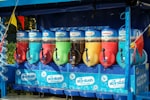Now the regular season is over and the salary cap is gone, the Leafs can just fill the press box with all the AHLers they want. It's time for Black Aces!
Not so fast.
Just because the Leafs season is over, doesn't mean all the rules governing player movement are suspended. There's more to the CBA than the salary cap, and the important bit is this part of Article 13.12:
(n) Following the conclusion of the Regular Season, no Player may be Recalled from Loan to a club of any league affiliated with the NHL, except that:
(i) a Club may exercise an unlimited number of additional regular Recalls, provided that it may have no more than three (3) Players on its Active Roster who were Recalled by way of regular Recall after the Trade Deadline. However, if a Club has Recalled four (4) Players pursuant to Section 13.12(l) above, such Club will instead be permitted to retain those four (4) Players on its Active Roster following the conclusion of the Regular Season.
(ii) Players may be Recalled under Article 13.12(m).
(iii) Players may be Recalled upon completion of the regular season and playoff schedule of the club to which they were Loaned.
The base state is that teams can't recall a player. Then there are three exceptions.
The third exception is the simple one, and just means that when the Marlies playoffs are over, the Leafs can recall all the players they like. The Marlies aren't even in the playoffs yet – the AHL season ends on Sunday. And they don't play in the first round. Due to the misaligned nature of the AHL divisions, they get a bye into the Division Semifinals while a best-of-three first round is played to determine their opponent. Assume the Marlies will be in action for about three more weeks at minimum. If they go all the way, that final is likely to be about the same time as the NHL final.
The second exception is the use of the same emergency rules that are in effect post trade deadline. This is not the Emergency Exception that gives a team a player free under the cap. This is an "ordinary" emergency recall that happens when a team has fewer than 12 forwards, six defenders and two goalies. In the regular season, this person requires cap space to be recalled. The distinction of an emergency and regular recall is used to measure waiver eligibility expiration and to determine the limit on player recalls post deadline.
There is a caveat on this second reason you can recall a player in the playoffs, and it reads:
(iii) For the purpose of establishing the existence of emergency conditions at any time, to support the Recall of a Player for participation in any Playoff Game, it shall be deemed that the Player(s) on Loan following 3:00 p.m. New York time of the fortieth (40th) day immediately preceding the last day of the Regular Season are continuing on Loan for the remainder of the season notwithstanding that the Loaned club(s) may have been eliminated from further play for the season.
That's a tough one (and it has a weird comma that shouldn't be there), let's reduce it down a little:
To get to use an emergency recall in the playoffs, all the players who were in the AHL after the trade deadline are deemed to be on permanent loan from now on. Even if the AHL team's season is over.
In other words, if you are using the emergency form of the recall, you better be sure there isn't a regular recall option left available to you of any kind because when you do it once, the entire rest of the players in the AHL are off limits for regular recall. Essentially, this very complex bit of business is there to prevent end runs around the first exception which I'll note for you again:
(i) a Club may exercise an unlimited number of additional regular Recalls, provided that it may have no more than three (3) Players on its Active Roster who were Recalled by way of regular Recall after the Trade Deadline. However, if a Club has Recalled four (4) Players pursuant to Section 13.12(l) above, such Club will instead be permitted to retain those four (4) Players on its Active Roster following the conclusion of the Regular Season.
This first exception is one of the most vexingly written passages in the CBA , even worse than that other bit above. Bob McKenzie got this clarified years ago, because the three recalls mentioned seems like it is three distinct people. So a recall of Bob, then of Mika, then Bob's sent down and Jesperi is recalled adds up to three recalls. But no, it means three at any one time, so the imaginary team Bob and Mika play on can recall one more after Bob is returned to the minors. The limit of four is a cumulative limit, the limit of three is a situational limit.
As alluded to in this rule, teams are limited to four uses of a regular recall after the trade deadline. The Leafs used none. Every single player, even Joe Woll when he was papered down and then back up on deadline day, has been recalled under emergency rules, which is a testament to how many forward and goalie injuries they had.
Why all the complexity? Because everything complicated in the CBA like this that upsets people exists to keep teams from endrunning the entire idea of the salary cap. If you could just recall everyone, then you can use your off-cap money to stock the AHL with players and suddenly bulk up at playoff time.
For the Leafs, blessed as they've been with injuries, all they need to do is recall players as needed on regular recall, ensuring they only have three at a time.
The Leafs can't fill up the pressbox, but they can get up to three players to keep Jake Muzzin and Conor Timmins company. What they actually end up doing will likely be determined by the playoff health of the Maple Leafs as the games go on.






